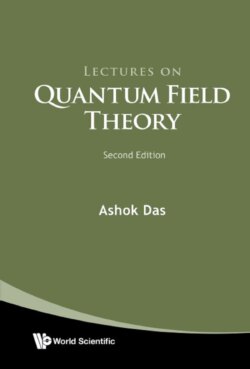Читать книгу Lectures on Quantum Field Theory - Ashok Das - Страница 8
На сайте Литреса книга снята с продажи.
ОглавлениеContents
Preface
1Relativistic equations
1.1Introduction
1.2Notations
1.3Klein-Gordon equation
1.3.1Klein paradox
1.4Dirac equation
1.5References
2Solutions of the Dirac equation
2.1Plane wave solutions
2.2Normalization of the wave function
2.3Spin of the Dirac particle
2.4Continuity equation
2.5Dirac’s hole theory
2.6Properties of the Dirac matrices
2.6.1Fierz rearrangement
2.7References
3Properties of the Dirac equation
3.1Lorentz transformations
3.2Covariance of the Dirac equation
3.3Transformation of bilinears
3.4Projection operators, completeness relation
3.5Helicity
3.6Massless Dirac particle
3.7Chirality
3.8Non-relativistic limit of the Dirac equation
3.9Electron in an external magnetic field
3.10Foldy-Wouthuysen transformation
3.11Zitterbewegung
3.12References
4Representations of Lorentz and Poincaré groups
4.1Symmetry algebras
4.1.1Rotation
4.1.2Translation
4.1.3Lorentz transformation
4.1.4Poincaré transformation
4.2Representations of the Lorentz group
4.2.1Similarity transformations and representations
4.3Unitary representations of the Poincaré group
4.3.1Massive representation
4.3.2Massless representation
4.4References
5Free Klein-Gordon field theory
5.1Introduction
5.2Lagrangian density
5.3Quantization
5.4Field decomposition
5.5Creation and annihilation operators
5.6Energy eigenstates
5.7Physical meaning of energy eigenstates
5.8Green’s functions
5.9Covariant commutation relations
5.10References
6Self-interacting scalar field theory
6.1Nöther’s theorem
6.1.1Space-time translation
6.2Self-interacting ϕ4 theory
6.3Interaction picture and time evolution operator
6.4S-matrix
6.5Normal ordered product and Wick’s theorem
6.6Time ordered products and Wick’s theorem
6.7Spectral representation and dispersion relation
6.8References
7Complex scalar field theory
7.1Quantization
7.2Field decomposition
7.3Charge operator
7.4Green’s functions
7.5Spontaneous symmetry breaking and the Goldstone theorem
7.6Electromagnetic coupling
7.7References
8Dirac field theory
8.1Pauli exclusion principle
8.2Quantization of the Dirac field
8.3Field decomposition
8.4Charge operator
8.5Green’s functions
8.6Covariant anti-commutation relations
8.7Normal ordered and time ordered products
8.8Massless Dirac fields
8.9Yukawa interaction
8.10Feynman diagrams
8.11References
9Maxwell field theory
9.1Maxwell’s equations
9.2Canonical quantization
9.3Field decomposition
9.4Photon propagator
9.5Quantum electrodynamics
9.6Physical processes
9.7Ward-Takahashi identity in QED
9.8Covariant quantization of the Maxwell theory
9.9References
10Dirac method for constrained systems
10.1Constrained systems
10.2Dirac method and Dirac bracket
10.3Particle moving on a sphere
10.4Relativistic free particle
10.5Dirac field theory
10.6Maxwell field theory
10.7References
11Discrete symmetries
11.1Parity
11.1.1Parity in quantum mechanics
11.1.2Spin zero field
11.1.3Photon field
11.1.4Dirac field
11.2Charge conjugation
11.2.1Spin zero field
11.2.2Dirac field
11.2.3Majorana fermions
11.2.4Eigenstates of charge conjugation
11.3Time reversal
11.3.1Spin zero field and Maxwell’s theory
11.3.2Dirac fields
11.3.3 Consequences of T invariance
11.3.4Electric dipole moment of neutron
11.4CPT theorem
11.4.1Equality of mass for particles and antiparticles
11.4.2Electric charge for particles and antiparticles
11.4.3Equality of lifetimes for particles and antiparticles
11.5References
12Yang-Mills theory
12.1Non-Abelian gauge theories
12.2Canonical quantization of Yang-Mills theory
12.3Path integral quantization of gauge theories
12.4Path integral quantization of tensor fields
12.5References
13BRST invariance and its consequences
13.1BRST symmetry
13.2Covariant quantization of Yang-Mills theory
13.3Unitarity
13.4Slavnov-Taylor identity
13.5Feynman rules
13.6Ghost free gauges
13.7References
14Higgs phenomenon and the standard model
14.1Stückelberg formalism
14.2Higgs phenomenon
14.3The standard model
14.3.1Field content
14.3.2Lagrangian density
14.3.3Spontaneous symmetry breaking
14.4References
15Regularization of Feynman diagrams
15.1Introduction
15.2Loop expansion
15.3Cut-off regularization
15.3.1Calculation in the Yukawa theory
15.4Pauli-Villars regularization
15.5Dimensional regularization
15.5.1Calculations in QED
15.6References
16Renormalization theory
16.1Superficial degree of divergence
16.2A brief history of renormalization
16.3Schwinger-Dyson equation
16.4BPHZ renormalization
16.5Renormalization of gauge theories
16.6Anomalous Ward identity
16.7References
17Renormalization group and equation
17.1Gell-Mann-Low equation
17.2Renormalization group
17.3Renormalization group equation
17.4Solving the renormalization group equation
17.5Callan-Symanzik equation
17.6References
18Nielsen identities and gauge independence of physical parameters
18.1The problem
18.2Questions associated with the effective potential
18.3Gauge independence of the fermion mass
18.3.1Fermion mass
18.3.2Pole of the fermion Green’s function
18.3.3Interpolating gauge
18.3.4Nielsen identity for QED
18.3.5Gauge dependence of the pole of the propagator
18.3.6Infrared divergence and gauge dependence of fermion mass
18.4References
19Basics of global supersymmetry
19.1Graded Lie algebras
19.1.1Representations
19.2Supersymmetric quantum mechanics
19.3Supersymmetric field theories
19.3.1Wess-Zumino theory
19.3.2Vector multiplet
19.3.3Supersymmetric Higgs model
19.4Superspace
19.5References
Appendices
Appendix: More on fermions
A1Fermions in 4 dimensions
A2Spinors in D space-time dimensions
A3References
Appendix: Gauge invariant potential and the Fock-Schwinger gauge
B1Gauge invariant potential
B2Fock-Schwinger gauge
B3References
Index
